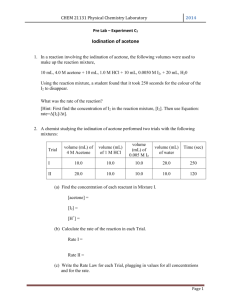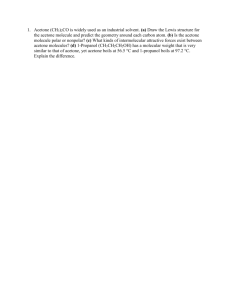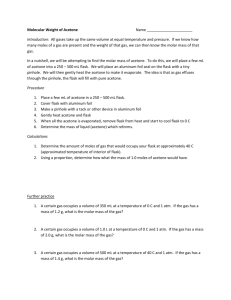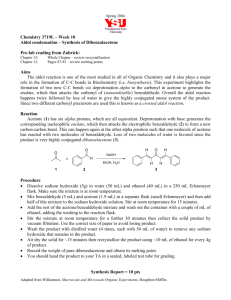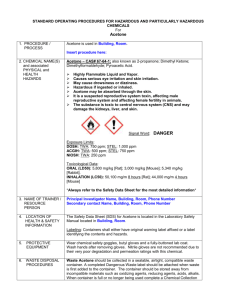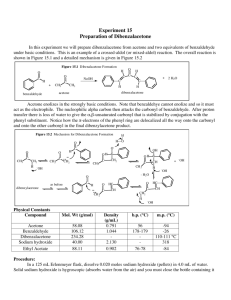Get - Wiley Online Library
advertisement
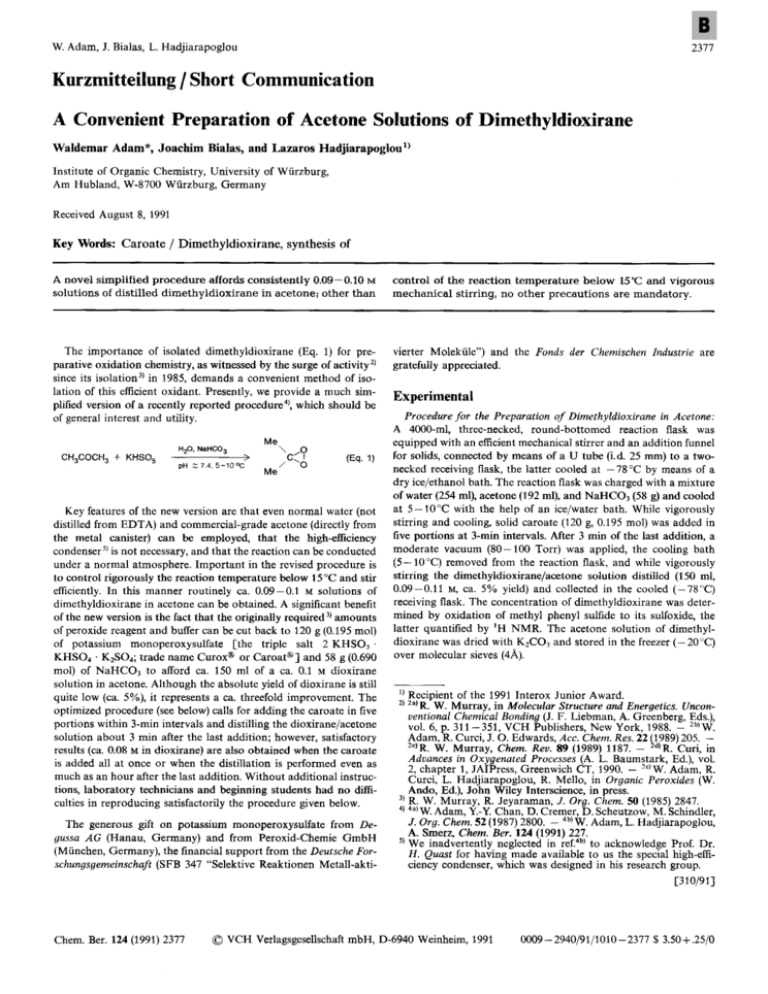
W. Adam, J. Bialas, L. Hadjiarapoglou 2377 Kurzmitteilung/ Short Communication A Convenient Preparation of Acetone Solutions of Dimethyldioxirane Waldemar Adam*, Joachim Bialas, and Lazaros Hadjiarapoglou’) Institute of Organic Chemistry, University of Wiirzburg, Am Hubland, W-8700 Wurzburg, Germany Received August 8, 1991 Key Words: Caroate ,/ Dimethyldioxirane, synthesis of ~ ~~ ~ A novel simplified procedure affords consistently 0.09-0.10 M solutions of distilled dimethyldioxirane in acetone: other than control of the reaction temperature below 15°C and vigorous mechanical stirring, no other precautions are mandatory. The importance of isolated dimethyldioxirane (Eq. 1) for preparative oxidation chemistry, as witnessed by the surge of activity2) since its isolation3) in 1985, demands a convenient method of isolation of this efficient oxidant. Presently, we provide a much simplified version of a recently reported procedure4),which should be of general interest and utility. vierter Molekule”) and the Fonds der Chemischen Industrie are gratefully appreciated. CH,COGH, + H20. NaHC03 Me KHSO, pH Z 7 4 . 5 - 1 O o C (Eq. 1) Me Key features of the new version are that even normal water (not distilled from EDTA) and commercial-grade acetone (directly from the metal canister) can be employed, that the high-efficiency condenser 5, is not necessary, and that the reaction can be conducted under a normal atmosphere. Important in the revised procedure is to control rigorously the reaction temperature below 15°C and stir efficiently. In this manner routinely ca. 0.09-0.1 M solutions of dimethyldioxirane in acetone can be obtained. A significant benefit of the new version is the fact that the originally required3)amounts of peroxide reagent and buffer can be cut back to 120 g (0.195 mol) of potassium monoperoxysulfate [the triple salt 2 K H S 0 5 . KHS04 . K2S04;trade name Curox@ or Caroat@]and 58 g (0.690 mol) of NaHC03 to afford ca. 150 ml of a ca. 0.1 M dioxirane solution in acetone. Although the absolute yield of dioxirane is still quite low (ca. 5%), it represents a ca. threefold improvement. The optimized procedure (see below) calls for adding the caroate in five portions within 3-min intervals and distilling the dioxirane/acetone solution about 3 min after the last addition; however, satisfactory results (ca. 0.08 M in dioxirane) are also obtained when the caroate is added all at once or when the distillation is performed even as much as an hour after the last addition. Without additional instructions, laboratory technicians and beginning students had no dificulties in reproducing satisfactorily the procedure given below. The generous gift on potassium monoperoxysulfate from Degussa AG (Hanau, Germany) and from Peroxid-Chemie GmbH (Munchen, Germany), the financial support from the Deutsche Forschungsgemeinschaft (SFB 347 “Selektive Reaktionen Metall-akti- Chem. Ber. 124 (1991) 2377 Experimental Procedure for the Preparation of Dimethyldioxirane in Acetone: A 4000-ml, three-necked, round-bottomed reaction flask was equipped with an efficient mechanical stirrer and an addition funnel for solids, connected by means of a U tube (i.d. 25 mm) to a twonecked receiving flask, the latter cooled at - 78 “C by means of a dry ice/ethanol bath. The reaction flask was charged with a mixture of water (254 ml), acetone (192 ml), and NaHC03 (58 g) and cooled at 5 - 10°C with the help of an ice/water bath. While vigorously stirring and cooling, solid caroate (120 g, 0.195 mol) was added in five portions at 3-min intervals. After 3 min of the last addition, a moderate vacuum (80- 100 Torr) was applied, the cooling bath (5-10°C) removed from the reaction flask, and while vigorously stirring the dimethyldioxirane/acetone solution distilled (1 50 ml, 0.09-0.11 M, ca. 5% yield) and collected in the cooled (-78°C) receiving flask. The concentration of dimethyldioxirane was determined by oxidation of methyl phenyl sulfide to its sulfoxide, the latter quantified by ‘H NMR. The acetone solution of dimethyldioxirane was dried with K2C03and stored in the freezer (-20°C) over molecular sieves ( 4 4 . Recipient of the 1991 Interox Junior Award. ’“R. W. Murray, in Molecular Structure and Energetics. Unconventional Chemical Bonding (J. F. Liebman, A. Greenberg, Eds.), vol. 6, p. 311 -351, VCH Publishers, New York, 1988. - Zb)W. Adam, R. Curci, J. 0.Edwards, Acc. Chem. Res. 22 (1989) 205: I 2c)R. W. Murray, Chem. Rev. 89 (1989) 1187. - d)R. Cun, in Advances in Oxygenated Processes (A. L. Baumstark, Ed.), vol. 2, chapter 1, JAIPress, Greenwich CT, 1990. - 2e)W.Adam, R. Curci, L. Hadjiarapoglou, R. Mello, in Organic Peroxides (W. Ando, Ed.), John Wiley Interscience, in press. 3, R. W. Murray, R. Jeyaraman, J . Org. Chem. 50 (1985) 2847. 4, 4a) W. Adam, Y.-Y. Chan, D. Cremer, D. Scheutzow, M. Schindler. J. Org. Chem. 52 (1987) 2800. - 4b)W.Adam, L. Hadjiarapoglou; A. Smerz, Chem. Ber. 124 (1991) 227. )’ We inadvertentlv neglected in ref!b) to acknowledee Prof. Dr. H. Quast for haGingkade available to us the spezal high-eficiency condenser, which was designed in his research group. [310/91] I) 2, 0VCH Verlagsgesellschaft mbH, D-6940 Weinheim, 1991 0009-2940/91/1010-2377 $ 3.50+.25/0
